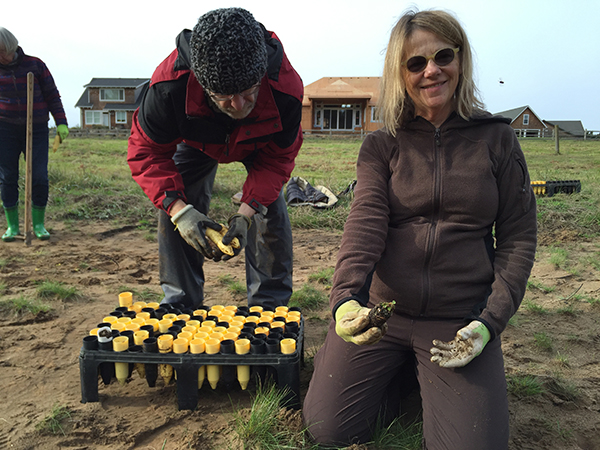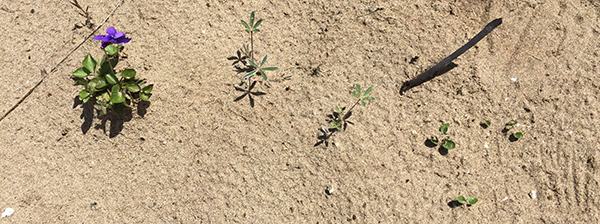Two-and-a-half years ago, North Coast Land Conservancy appealed to the community to help plant nearly 9,000 early blue violet seedlings on its habitat reserves in the Clatsop Plains. The goal: to restore the coastal prairie that native butterflies need to survive. More than 90 volunteers of all ages—children and their parents, high school students, retirees—showed up and managed, over one cool November weekend, to get all the violets in the ground.
The next day, the north coast of Oregon had a cold snap. That winter was followed by an unseasonably warm, dry summer. Did enough violets survive to make all that effort worthwhile?
Without a doubt, says NCLC Stewardship Director Melissa Reich. The proof is in the thousands of violet “babies” appearing this spring in NCLC’s test plots next to the violets planted in November 2015. Those babies sprung from seed produced by the original violet seedlings. “We did have some losses,” she says, but “all those that made it are flowering and doing really well.”

Volunteers planting early blue violets at Neacoxie Forest in November 2015
The project yielded a number of lessons for NCLC and other organizations working to restore coastal prairie habitat. Before the violets were planted, NCLC experimented with three “treatments” for getting rid of invasive grasses to create room for native plant species. Working with the Institute for Applied Ecology, they applied herbicides to some plots, inverted the topsoil in other plots, and entirely removed the topsoil—exposing the sand beneath—in a third group of plots. Topsoil removal had proved the most effective treatment, which is why NCLC planted the violets in those plots. Now the plots treated with herbicides are thick with weeds—Scotch broom in particular—while the plots where the violets were planted have surprisingly few weeds.
In addition, Melissa says, “People were skeptical about whether the violets could survive in the sandy soil. We’re showing that they can survive, and that that soil is good at keeping away weeds.” In other places where early blue violets have been reintroduced in richer soil, they have often been quickly overwhelmed by invasive, non-native grasses.
NCLC is seeking volunteers to join a stewardship day on June 10 to weed the coastal prairie. The few weeds that have appeared alongside the violets in the test plots are very small and can be hard to tell from native plants, so NCLC staff will start the day by teaching volunteers how to tell the weeds from the natives.

Left to right: Mature early blue violet planted in 2015 and now in bloom, native lupine, and “baby” violets, all growing in test plot at NCLC’s Reed Ranch Habitat Reserve.
Comments